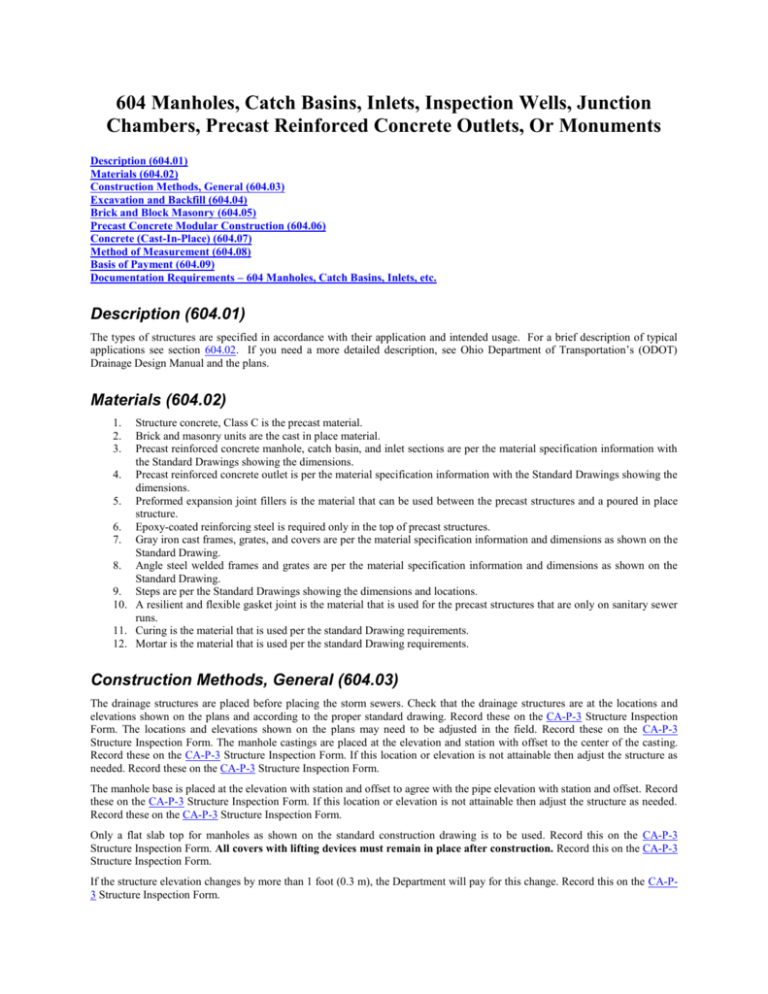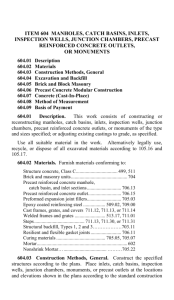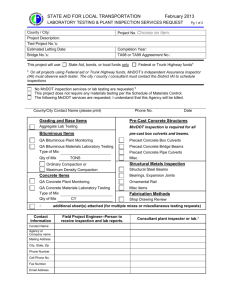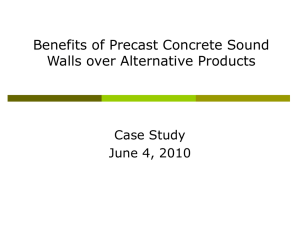604 Manholes, Catch Basins, Inlets, Inspection Wells, Junction
advertisement

604 Manholes, Catch Basins, Inlets, Inspection Wells, Junction Chambers, Precast Reinforced Concrete Outlets, Or Monuments Description (604.01) Materials (604.02) Construction Methods, General (604.03) Excavation and Backfill (604.04) Brick and Block Masonry (604.05) Precast Concrete Modular Construction (604.06) Concrete (Cast-In-Place) (604.07) Method of Measurement (604.08) Basis of Payment (604.09) Documentation Requirements – 604 Manholes, Catch Basins, Inlets, etc. Description (604.01) The types of structures are specified in accordance with their application and intended usage. For a brief description of typical applications see section 604.02. If you need a more detailed description, see Ohio Department of Transportation’s (ODOT) Drainage Design Manual and the plans. Materials (604.02) 1. 2. 3. Structure concrete, Class C is the precast material. Brick and masonry units are the cast in place material. Precast reinforced concrete manhole, catch basin, and inlet sections are per the material specification information with the Standard Drawings showing the dimensions. 4. Precast reinforced concrete outlet is per the material specification information with the Standard Drawings showing the dimensions. 5. Preformed expansion joint fillers is the material that can be used between the precast structures and a poured in place structure. 6. Epoxy-coated reinforcing steel is required only in the top of precast structures. 7. Gray iron cast frames, grates, and covers are per the material specification information and dimensions as shown on the Standard Drawing. 8. Angle steel welded frames and grates are per the material specification information and dimensions as shown on the Standard Drawing. 9. Steps are per the Standard Drawings showing the dimensions and locations. 10. A resilient and flexible gasket joint is the material that is used for the precast structures that are only on sanitary sewer runs. 11. Curing is the material that is used per the standard Drawing requirements. 12. Mortar is the material that is used per the standard Drawing requirements. Construction Methods, General (604.03) The drainage structures are placed before placing the storm sewers. Check that the drainage structures are at the locations and elevations shown on the plans and according to the proper standard drawing. Record these on the CA-P-3 Structure Inspection Form. The locations and elevations shown on the plans may need to be adjusted in the field. Record these on the CA-P-3 Structure Inspection Form. The manhole castings are placed at the elevation and station with offset to the center of the casting. Record these on the CA-P-3 Structure Inspection Form. If this location or elevation is not attainable then adjust the structure as needed. Record these on the CA-P-3 Structure Inspection Form. The manhole base is placed at the elevation with station and offset to agree with the pipe elevation with station and offset. Record these on the CA-P-3 Structure Inspection Form. If this location or elevation is not attainable then adjust the structure as needed. Record these on the CA-P-3 Structure Inspection Form. Only a flat slab top for manholes as shown on the standard construction drawing is to be used. Record this on the CA-P-3 Structure Inspection Form. All covers with lifting devices must remain in place after construction. Record this on the CA-P-3 Structure Inspection Form. If the structure elevation changes by more than 1 foot (0.3 m), the Department will pay for this change. Record this on the CA-P3 Structure Inspection Form. Ensure that the underdrain outlet pipe is thoroughly mortared to the precast reinforced concrete outlet. All lateral sewer connections including drops and leads except pipe included in 603 is part of the structure for payment. Record these on the CA-P-3 Structure Inspection Form. Ensure that the conduit is as shown on the standard construction drawings (that is, they do not protrude inside the structure walls). Record this on the CA-P-3 Structure Inspection Form. Ensure that structure concrete or mortar cement is not freezing. Record these temperatures on the CA-P-3 Structure Inspection Form. If the ambient temperature is 40° F (4° C) or less ensure that the precast concrete structure throughout the entire mass is a temperature of between 50 and 80° F (10 and 27° C) before the contractor places the mortar. Record these temperatures on the CA-P-3 Structure Inspection Form. Ensure that all iron frames, tops, and covers of the type shown on the plans are placed on a mortar bed. Record this on the CA-P3 Structure Inspection Form. Ensure that all earth or debris resulting from construction operations that enter the manholes, catch basins, junction chamber, inlets, and precast reinforced concrete outlets is removed. Record these removals on the CA-P-3 Structure Inspection Form. If reconstruction is specified, ensure the following are performed: 1. 2. 3. 4. The existing castings are carefully removed and clean. For manholes, remove the existing walls down to the spring line or below as necessary. Record the depth of removal on the CA-P-3 Structure Inspection Form. For catch basins and inlets, remove existing walls below the window openings, grates, or any points of wall failure. Record the depth of removal on the CA-P-3 Structure Inspection Form. Using the salvaged casting, reconstruct the structure to the new grade, conforming as nearly as practicable to the existing dimension and type of construction. Record this elevation on the CA-P-3 Structure Inspection Form. If adjustment to grade is specified, ensure the following are performed: 1. 2. Carefully remove the existing frame, adjust the height of supporting walls, and then reset the existing frame in a bed of mortar or structure concrete to the new grade. Record this work and elevation on the CA-P-3 Structure Inspection Form. Ensure the existing cover or grate is removed and cleaned and then one of the following is done: Record this work and elevation on the CA-P-3 Structure Inspection Form. a. A new casting is installed to provide the proper elevation or b. An approved adjusting device that is on file at the Laboratory is installed to provide the proper elevation or c. An adjusting device approved by the Engineer is installed per the manufacturer’s recommendations to provide the proper elevation. Excavation and Backfill (604.04) Ensure that the excavation is to dimensions that provide ample room for construction. Require the removal of unsuitable material below the structure bedding. The contractor must replace unsuitable material with Item 603 Structural Backfill. Record the material type and depth on the CA-P-3 Structure Inspection Form. The Department will provide compensation for this removal and replacement of unsuitable material below the bedding for precast structures, and below the structure for cast-in-place structures, according to the Contract or by Supplemental Agreement. Backfilling follows the completion of the work as closely as the type of construction will permit. Ensure that the structure while backfilling is not disturbed. Backfill structures located within the pavement area with structural backfill to the subgrade according to Item 603, Type A or B conduit. Backfill structures located outside of the pavement area according to Item 603, Type C conduit. Record the material type and elevation depth on the CA-P-3 Structure Inspection Form for each structure. Brick and Block Masonry (604.05) Ensure that all brick and concrete block masonry units are thoroughly wet before laying them in the mortar, and that they are laid with full mortar joints. Ensure that the concrete and mortar do not freeze. Do not set brick and masonry units having a temperature of 40° F (4° C) or less with mortar until heated. When required, heat to ensure that a temperature of 50 to 80° F (10 to 27° C) is obtained throughout the entire mass of the material. Record the temperature on the CA-P-3 Structure Inspection Form. Ensure that the exposed surfaces of all brick and block masonry are cured by covering them with wet burlap for 48 hours or by applying curing membrane according to Item 511. Record the curing type on the CA-P-3 Structure Inspection Form. Precast Concrete Modular Construction (604.06) Ensure that furnished precast bases are on a compacted structural backfill bed having a minimum thickness of 3 inches (75 mm). Ensure that the structural backfill bed is level and uniformly supports the entire area of the base. Record the material used and how that material was compacted on the CA-P-3 Structure Inspection Form. Ensure that all openings in the structures are thoroughly filled with mortar. Ensure that all joints are sealed between modules with materials specified in Item 603 for Type A, B, C, D, or F conduit. Ensure that median inlets are cured with the same materials and methods specified in 622.07. Ensure that the manufacturer of precast modular items is certified according to Supplement 1073. Concrete (Cast-In-Place) (604.07) Ensure that the structure concrete is placed and furnish as shown on the plans. Record all information on the CA-P-3 Structure Inspection Form as required by Item 511. Method of Measurement (604.08) The Department will measure Manholes, Inlets, Catch Basins, Monument Assemblies, Reference Monuments, Inspection Wells, Junction Chambers, and Precast Reinforced Concrete Outlets, whether new, reconstructed, or adjusted to grade, by the number of each type of structure complete and accepted. Record each type on the CA-P-3 Structure Inspection Form that is paid for that day. Basis of Payment (604.09) The Department will pay for accepted quantities at the contract prices. . Record the reference Item number on the CA-P-3 Structure Inspection Form. Documentation Requirements - 604 Manholes, Catch Basins, Inlets, etc. 1. 2. 3. 4. Catch Basin a. Pad dimensions (length x width x depth) b. Blocks wet prior to placing c. Mortar composition, one part cement to two parts sand by volume d. Full mortar joint used e. How cured f. Take adequate measures to keep concrete from freezing. State method used g. Backfill placed as per 603.10, 603.11 h. Measure inside dimensions Pre-cast catch basin or manhole a. Precast basin set on a bed of compacted granular material (type of granular material used) b. Must be produced by a certified precast concrete producer and shipped with a TE-24. c. All openings in structure sealed with (mortar or bituminous material) d. Backfill placed in 4 inch (10 cm) loose lifts and tamped Manholes a. Pad dimensions - length x width x depth or diameter and depth b. Joints between riser section sealed by rubber gasket or mastic material c. Backfill placed in 4 inch (10 cm) loose lifts and tamped d. Steps are required e. All openings made in manhole sealed with concrete or grout f. Measure inside dimensions Inlets a. Pad dimensions (length x width x depth) b. Blocks wet prior to placing 5. 6. c. Mortar composition, one part cement to two parts sand by volume d. Full mortar joints used e. how cured f. Take adequate measures to keep concrete from freezing. State method used. g. Backfill placed in 4 inch (10 cm) loose lifts and tamped h. Measure inside dimension. Monument assemblies (as per standard drawing) a. Dimensions of concrete poured b. Diameter and depth of pipe placed c. Pipe filled with concrete sand compacted by flooding d. 1 inch (2.5 cm) diameter x 36 inch (91 cm) steel rod placed 3 inches (8 cm) minimum from bottom of pipe and 6 inches (15 cm) below pavement surface and on correct alignment Reference Monuments a. Diameter and depth of hole drilled b. Top 6 inches (15 cm) formed c. Hole filled with Class C concrete d. ½ inch (1 cm) steel rod embedded in plastic concrete to a depth of 6 inches (15 cm) on correct alignment e. Top cured f. Document on CA-P-3.






